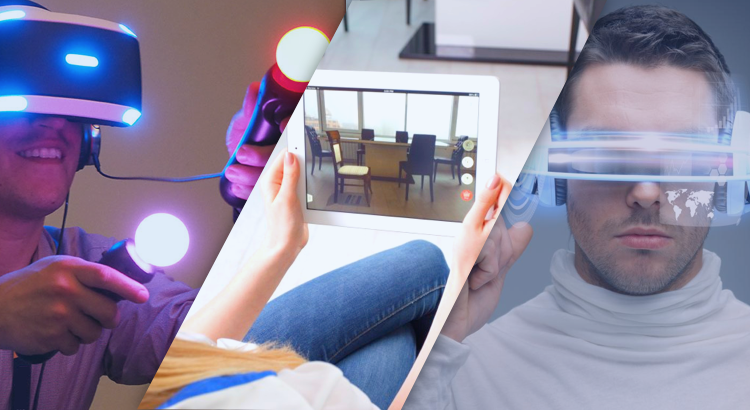The Future Realities: Augmented, Virtual, and Mixed
We all know how the digital revolution unleashed by smartphones overturned the world we once knew. Almost overnight, the world moved from physical transactions to e-commerce and m-commerce. We certainly did not expect things to end there; there was only the question of what the next big thing would be. Dubbed the Fourth Transformation, the next set of sweeping changes are expected to happen in the intersection between technology and experience. Virtual, augmented, and mixed realities are getting real, blurring the difference between the physical and the virtual. What are these different realities and how are they different from one another? Here’s a primer on them:Augmented Reality
Think Pokemon GO. Augmented reality (AR) is created by creating a virtual overlay on the real world and triggering it using GPS, visual, or audio input. You need a device, such as a smartphone, to view the virtual overlay. Intelligent headsets provide a more immersive experience. A popular business application in this sector is the IKEA catalog application. IKEA customers can check out how different pieces of furniture will look like in their homes and choose the most flattering ones. Tango, Google’s AR platform, brings depth-sensing camera, similar to Intel’s RealSense technology, to mobile phones, revolutionizing the already accelerating AR space. Major players in this space include Vuforia, Tango, Blippar, Layar, and Lensar. Some of the silent giants are Apple (which acquired Metaio in 2015) and Amazon (which is rumored to be investing in computer vision). Any computer vision-based player would have a major say in this area. Some of the cool applications that leverage augmented reality can be found on Blippar. Some interesting games can be found on platforms like the Augmented Climbing Wall.Virtual Reality
Virtual reality lets you immerse in a simulated world by letting you have 360-degree vision and interaction with the objects around you using a head-mounted display. It follows a stereoscopic camera view, and hence the rendering would require a powerful GPU. Of course, there are cardboards, Gear VR, and so on, but they would be able to only render certain quality levels unlike an Oculus or Vive. There are add-ons to many virtual reality gadgets that can simulate touch, shock, and so on. There are even smell diffusers that enrich the experience. In that sense, many VR gadgets are extensions of our sensory organs. Imagine being transported into a movie you are watching or getting to know ancient cities up close. Given the staggering possibilities, virtual reality is much sought after in entertainment, marketing, e-learning, and gaming industries. Several commercial applications have also joined the fray. Some of the major players in this area include Oculus Rift, GearVR, Cardboard, HTC Vive, OSVR, PSVR, Jaunt, Matterport, Kolor, and Beloola.Mixed Reality
Now, in my opinion, this is the real deal. As the name suggests, Mixed Reality or Merged Reality (MR) is a hybrid of VR and AR. You overlay the local world on the real world but with interactions enabled between them. This is also known as holographic computing, where the digital content of our application interacts with real world objects and surroundings. Mixed reality experience is therefore out of the world. Just imagine having something similar to Iron Man's Jarvis. It’s the best blend of computer vision and experience. Companies in the education, commerce, entertainment, and automobile sectors can benefit a lot from this technology space. Major players here are MS Hololens, Canon MREAL, and Magic Leap.Augmented vs. Virtual vs. Mixed
Amongst the different realities, augmented reality and mixed reality may have an edge over virtual reality as they would utilize computer vision at a great scale and allow more interactions with the surroundings. For VR, the CPU/GPU requirements are very high for high-end devices due to the possibility of VR sickness. AR and MR will have a similar role to wearables and mobiles and will be influential in sectors like rCommerce (like eCommerce), web browsing, home automation, and so on.Game Changing Business Realities
There is no doubt that within the next 10 years, this space will grow exponentially. There is a lot of development to be done on the software as well as hardware front. The possibility of earning billions in revenue is very high since we are at the beginning of the curve. Expert analysts predict the industry to be worth close to USD 150 billion by 2020. Most industries will feel the impact, and a host of capabilities will be called for. Look out for trailblazers in e-commerce, teleconferencing, e-learning, real estate, car demo, and driver learning applications, not to forget games and movies. Whatever the future beholds, it certainly looks bright and real for hardware and software developers. For startups, there is a plenty of room to ideate and develop. For enterprises, there is a whole new world of products and applications to be made. Believe me, there is no escape from this reality. So what are you waiting for? Go explore, ideate, and create. Happy developing!
Whatever the future beholds, it certainly looks bright and real for hardware and software developers. For startups, there is a plenty of room to ideate and develop. For enterprises, there is a whole new world of products and applications to be made. Believe me, there is no escape from this reality. So what are you waiting for? Go explore, ideate, and create. Happy developing! 
